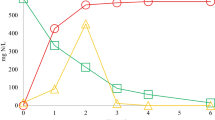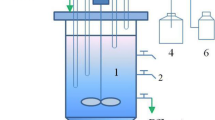Abstract
In this study, an improved system called the completely autotrophic nitrogen removal over nitrite (CANON) process was presented and coupled with denitrification for the treatment of digested piggery wastewater (DPW). The effects of operating parameters, including hydraulic retention time (HRT) (1.6 d → 1.0 d), influent NH4+-N concentration (350 mg L−1 → 600 mg L−1), and temperature (41 ℃ → 17 ℃), on the nitrogen removal performance and response characteristics of microbial population were investigated. Results showed that all considered parameters caused a remarkable effect on NH4+-N and total nitrogen removal efficiencies, and the chemical oxygen demand was more markedly affected by temperature. Candidatus_Kuenenia, Candidatus_Brocadia, Denitratisoma, norank_o_Xanthmonadales, norank_p_WWE3, and SM1A02 were the dominant genera influencing nitrogen removal in the improved CANON system for treating DPW. Redundancy discriminant analysis showed that the biological structure was positively correlated with the influent ammonium concentration, temperature, and HRT. The relative abundance of Candidatus_Kuenenia was perfectly correlated with HRT and temperature. However, environmental factors did not affect Candidatus_Brocadia and norank_p_WWE3. norank_c_Ardenticatenia, SM1A02, and norank_f_SJA-28 were all positively correlated with influent ammonium nitrogen concentration, but not correlated with HRT and temperature. The improved CANON process realized the nitrogen removal under high ammonium (NH4+-N) concentration and low C/N wastewater.





Similar content being viewed by others
References
Kizito S, Wu SB, Wandera SM, Guo L, Dong RJ (2016) Evaluation of ammonium adsorption in biochar-fixed beds for treatment of anaerobically digested swine slurry: experimental optimization and modeling. Sci Total Environ 563–564:1095–1104. https://doi.org/10.1016/j.scitotenv.2016.05.149
Meng J, Li J, Li J, Wang C, Deng K, Sun K (2016) Effect of seed sludge on nitrogen removal in a novel upflow microaerobic sludge reactor for treating piggery wastewater. Bioresour Technol 216:19–27. https://doi.org/10.1016/j.biortech.2016.05.034
Xin X, Liu Q, Werner D, Lu H, Qin JW (2020) Start-up strategy and bacterial community analysis of SNAD process for treating anaerobic digester liquor of swine wastewater (ADLSW) in a continuous-flow biofilm reactor. Water Environ J 34:661–671. https://doi.org/10.1111/wej.12568
Wang B, Yang L, Sun B, Liu YL (2020) Theory and research development of biological denitrification process. Constr Budget 11:5–7. https://doi.org/10.13993/j.cnki.jzyys.2020.11.001
Yang H (2020) Performance and mechanism of autotrophic nitrogen removal from digested effluent of swine wastewater mediated by zero-valent iron(ZVI). Chinese Acad Agric Sci. https://doi.org/10.27630/d.cnki.gznky.2020.000501
Wang XY, Xie B, Zhang CQ, Shen YS, Lu J (2017) Quantitative impact of influent characteristics on nitrogen removal via and denitrification in a landfill bioreactor case. Bioresour Technol 224:130–139. https://doi.org/10.1016/j.biortech.2016.11.078
Zhang ZZ, Zhang Y, Chen YG (2020) Recent advances in partial denitrification in biological nitrogen removal: from enrichment to application. Bioresour Technol 298:122444. https://doi.org/10.1016/j.biortech.2019.122444
Liu XJ (2020) Study on start-up and stable operation of canon process for treating medium and low concentration nitrogenous wastewater. Beijing Univ Chem Technol. https://doi.org/10.26939/d.cnki.gbhgu.2020.000257
Zhang L, Zhang SJ, Peng YZ, Han XY, Gan YP (2015) Nitrogen removal performance and microbial distribution in pilot- and full-scale integrated fixed-biofilm activated sludge reactors based on nitritation-anammox process. Bioresour Technol 196:448–453. https://doi.org/10.1016/.j.biortech.2015.07.090
Mousavi SA, Mehralian M, Khashij M, Ibrahim S (2018) Effect of air flow rate and C/N ratio on biological nitrogen removal through the CANON process treating reject water. Environ Technol 39:2891–2899. https://doi.org/10.1080/09593330.2017.1369578
Zhang XJ, Zhang N, Wang LN, Zheng KW, Hu HQ, Chen T, Zhang HZ, Yan XX (2017) Bioactivity and microbial community structure of nitrite-oxidizing bacteria in five membrane bioreactors operated as CANON process with different C/N ratio. Ecol Eng 99:159–163. https://doi.org/10.1016/j.ecoleng.2016.11.049
Chen H, Wei YX, Xie CL, Wang H, Chang S, Xiong Y, Du CY, Xiao BY, Yu GL (2020) Anaerobic treatment of glutamate-rich wastewater in a continuous UASB reactor: effect of hydraulic retention time and methanogenic degradation pathway. Chemosphere 245:1–34. https://doi.org/10.1016/j.chemosphere.2019.125672
Zhang YL, Li J, Bian W, Li Y, Yang QY (2018) The quick starting up of CANON process for the nitrogen removal by coordinating C/N and HRT. Technol Water Treat 44:87–93. https://doi.org/10.1016/j.procbio.2019.06.010
Meng YB, Zhou ZB, Meng FG (2019) Impacts of diel temperature variations on nitrogen removal and metacommunity of anammox biofilm reactors. Water Res 160:1–9. https://doi.org/10.1016/j.watres.2019.05.021
Han XY, Sun YF, Zhang SJ, Li X, Cao XS, Peng YZ (2018) Effect of influent ammonium concentration on CANON process for two sludge systems. J Harbin Inst Technol 50:40–45. https://doi.org/10.11918/j.issn.0367-6234.201705060
Li D, Yang Z, Liang YH, Gao WN, Wu QL, Su QL, Zhang J (2014) Nitrogen removal performance by CANON biological filtration with denitrfication. China Environ Sci 34:1448–1456. https://doi.org/10.3969/j.issn.1000-6923.2014.06
Zhang XJ, Li D, Liang YH, Zhang J (2015) Reactor performance and microbial characteristics of CANON process with step-wise increasing of C/N ratio. Environ Techno 37:407–414. https://doi.org/10.1080/09593330.2015.1070921
Wang ZL, Xin X, Wang L, Du RT, Li YL, Gou YX (2018) Start-up and microbial communities analysis of CANON process for the treatment of anaerobic digester liquor of swine wastewater (ADLSW). Acta Sci Circum 38:3945–3953. https://doi.org/10.1016/J.CEJ.2020.128221
Lotti T, Kleerebezem R, Hu Z, Kartal B, Jetten M, Van Loosdrecht M (2014) Simultaneous partial nitritation and anammox at low temperature with granular sludge. Water Res 66:111–121. https://doi.org/10.1016/j.watres.2014.07.047
Cao SB, Wang SY, Peng YZ, Wu CC, Du R, Gong LX, Ma B (2013) Achieving partial denitrification with sludge fermentation liquid as carbon source: the effect of seeding sludge. Bioresour Technol 149:570–574. https://doi.org/10.1016/j.biortech.2013.09.072
Du R, Cao SB, Wang SY, Niu M, Peng YZ (2016) Performance of partial denitrification (PD)-ANAMMOX process in simultaneously treating nitrate and low C/N domestic wastewater at low temperature. Bioresour Technol 219:420–429. https://doi.org/10.1016/j.biortech.2016.07.101
APHA (1998) Standard methods for the examination of water and wastewater, 20th edn. American Public Health Association, American Water Works Association, Water Pollution Control Federation, Washington
Zhen B, Masashi T, Giri P, Satoshi S, Zhou JT, Qiao S, Michihiko I (2015) Effects of the C/N ratio and bacterial populations on nitrogen removal in the simultaneous anammox and heterotrophic denitrification process: mathematic modeling and batch experiments. Chem Eng J 280:606–613. https://doi.org/10.1016/j.cej.2015.06.028
Meng J, Li JL, Li JZ, Astals S, Nan J, Deng KW, Philip A, Xu PP (2018) The role of COD/N ratio on the start-up performance and microbial mechanism of an upflow microaerobic reactor treating piggery wastewater. J Environ Manag 217:825–831. https://doi.org/10.1016/j.jenvman.2018.04.029
Li YF, Yu FR, Yang SJ, Ma CX (2020) Study on the influence of HRT, DO and organic compounds on the performance of ANAMMOx denitrification. Indust Water Treat 40:27–31. https://doi.org/10.11894/iwt.2019-0796
Tuong VH, Phuoc DN, Nhat P, Dssuy HL, Thi TVT, Khanh AH, Kenji F (2019) Application of CANON process for nitrogen removal from anaerobically pretreated husbandry wastewater. Int Biodeterior Biodegrad 136:15–23. https://doi.org/10.1016/j.ibiod.2018.09.010
Miao YY, Zhang L, Yang YD, Peng YZ, Li BK, Wang SY, Zhang Q (2016) Start-up of single-stage partial nitrification-anammox process treating low-strength swage and its restoration from nitrate accumulation. Bioresour Technol 218:771–779. https://doi.org/10.1016/j.biortech.2016.06.125
Fan NS, Bai YH, Wu J, Zhang Q, Fu JJ, Zhou WL, Huang BC, Jin RC (2020) A two-stage anammox process for the advanced treatment of high-strength ammonium wastewater: microbial community and nitrogen transformation. J Clean Prod. https://doi.org/10.1016/j.jclepro.2020.121148
Gong XF, Wang B, Qian X, Gong QT, Liu XF, Peng YZ (2020) Performance of the anammox process treating low-strength municipal wastewater under low temperatures: effect of undulating seasonal temperature variation. Bioresour Technol. https://doi.org/10.1016/j.biortech.2020.123590
Banach-Wiśniewska A, Ćwiertniewicz-Wojciechowska M, Ziembińska-Buczyńska A (2020) Effect of temperature shifts and anammox biomass immobilization on sequencing batch reactor performance and bacterial genes abundance. Int J Environ Sci Technol. https://doi.org/10.1007/s13762-020-02957-w
Pedrouso A, Angeles VDR, Morales N, Vazquez PJR, Campos JL, Mosquera CA (2021) Mainstream anammox reactor performance treating municipal wastewater and batch study of temperature, pH and organic matter concentration cross-effects. Process Saf Environ Prot 145:195–202. https://doi.org/10.1016/j.psep.2020.07.052
Vahid Z, Seyed MAM, Javad S, Fatemeh SD (2020) The effect of key factors in aerobic bioreactor and optimization by different strategies. Environ Techno Innov 18:1–14. https://doi.org/10.1016/j.eti.2020.100724
Farid S, Azadeh KP, Quan SH (2019) Evaluating the potential of a novel anaerobic baffled reactor for anaerobic digestion of thin stillage: effect of organic loading rate, hydraulic retention time and recycle ratio. Renew Energy 135:975–983. https://doi.org/10.1016/j.renene.2018.12.084
Mar P, Thiago DN, Joao G, Julián E, Alicia G, Alberto L, Javier A, Fernando FP (2019) Anaerobic submerged membrane bioreactor (AnSMBR) treating municipal wastewater at ambient temperature: operation and potential use for agricultural irrigation. Bioresour Technol 282:285–293. https://doi.org/10.1016/j.biortech.2019.03.019
Xie K, Wang B, Qiu LP, Zhang SB, Wang JB, Liu GC, Sun SF (2019) Performance and bacterial community composition of volcanic scoria particles (VSP) in a biological aerated filter (BAF) for micro-polluted source water treatment. Water Environ Res 91:954–967. https://doi.org/10.1002/wer.1139
Zhang MJ, Qiao S, Shao DH, Jin RF, Zhou JT (2018) Simultaneous nitrogen and phosphorus removal by combined anammox and denitrifying phosphorus removal process. J Chem Technol Biotechnol 93:94–104. https://doi.org/10.1002/jctb.5326
Liu ZG, Li AY, Wang YP, Iqbal M, Zheng AF, Zhao MM, Li ZK, Wang N, Wu C, Yu DP (2020) Comparative analysis of microbial community structure between healthy and Aeromonas veronii-infected Yangtze finless porpoise. Microb Cell Fact. https://doi.org/10.1186/s12934-020-01383-4
Liu CX, Dong YH, Hou LY, Deng N, Jiao RZ (2017) Acidobacteria community responses to nitrogen dose and form in Chinese fir plantations in Southern China. Curr Microbiol 74:396–403. https://doi.org/10.1007/s00284-016-1192-8
Peng L, Wang HY, Mao NJ, Ren HQ, Geng JJ, Xu K (2021) Cultivation of anammox sludge in an EGSB reactor with MnO2 powder addition. Acta Sci Circum 41:1283–1292. https://doi.org/10.13671/j.hjkxxb.2020.0401
Alejandro GM, Alejandro RS, Maria JGR, Barbara MP, Carmen CL, Franscisco O, Riku V (2016) Performance and bacterial community dynamics of a CANON bioreactor acclimated from high to low operational temperatures. Chem Eng J 287:557–567. https://doi.org/10.1016/j.cej.2015.11.081
Wang DP, Li T, Huang KL, He XW, Zhang XX (2019) Roles and correlations of functional bacteria and genes in the start-up of simultaneous anammox and denitrification system for enhanced nitrogen removal. Sci Total Environ 655:1355–1363. https://doi.org/10.1016/j.scitotenv.2018.11.321
Szabó E, Liébana R, Hermansson M, Modin O, Persson F, Wilén BM (2017) Microbial population dynamics and ecosystem functions of anoxic/aerobic granular sludge in sequencing batch reactors operated at different organic loading rates. Front Microbiol. https://doi.org/10.3389/fmicb.2017.00770
Yan LL, Zhang MY, Liu Y, Liu C, Zhang Y, Liu S, Yu LB, Hao GX, Chen ZL, Zhang Y (2019) Enhanced nitrogen removal in an aerobic granular sequencing batch reactor under low DO concentration: role of extracellular polymeric substances and microbial community structure. Bioresour Technol 289:1–36. https://doi.org/10.1016/j.biortech.2019.121651
Niranjan KS, Shigeru H, Toshi K (2001) conversion of ammonia to dinitrogen in wastewater by Nitrosomonas europaea. Appl biochem Biotechnol 90(3):221–232. https://doi.org/10.1385/ABAB:90:3:221
Fu KM, Zhou HT, Su XY, Wang HF (2017) Short-cut Nitrification Recovery and Its Transformation into CANON Process in a Biofilm Reactor. Environ Sci 38:1536–1543. https://doi.org/10.13227/j.hjkx.201609233
Liu LJ, Ji M, Wang F, Yan Z, Tian ZK, Wang SY, Wang SY (2020) Microbial community shift and functional genes in response to nitrogen loading variations in an anammox biofilm reactor. Int Biodeterior Biodegrad 153:1–8. https://doi.org/10.1016/j.ibiod.2020.105023
Zhang ZZ, Cheng YF, Liu YY, Zhang Q, Zhu BQ, Jin RC (2019) Deciphering the evolution characteristics of extracellular microbial products from autotrophic and mixotrophic anammox consortia in response to nitrogen loading variations. Environ Int 124:501–510. https://doi.org/10.1016/j.envint.2018.12.034
Acknowledgements
This work was supported jointly by Technology Innovation Research Project of the Chengdu Science and Technology Bureau (Grant No. 2022-YF05-00811-SN) and Scientific Research Project of Shanxi Province Meteorological Bureau (Grant No. SXKZDDW20217105).
Author information
Authors and Affiliations
Corresponding author
Ethics declarations
Conflict of interest
The authors declare that they have no conflict of interest.
Additional information
Publisher's Note
Springer Nature remains neutral with regard to jurisdictional claims in published maps and institutional affiliations.
Rights and permissions
Springer Nature or its licensor (e.g. a society or other partner) holds exclusive rights to this article under a publishing agreement with the author(s) or other rightsholder(s); author self-archiving of the accepted manuscript version of this article is solely governed by the terms of such publishing agreement and applicable law.
About this article
Cite this article
Xin, X., Cao, X. & Wang, ·. Integrated effects of operational temperature, HRT, and influent ammonium concentration on a CANON coupling with denitrification process treating for digested piggery wastewater: performance and microbial community. Bioprocess Biosyst Eng 46, 1–13 (2023). https://doi.org/10.1007/s00449-022-02804-x
Received:
Accepted:
Published:
Issue Date:
DOI: https://doi.org/10.1007/s00449-022-02804-x




